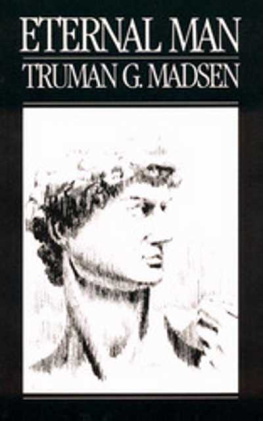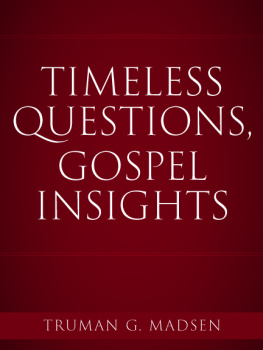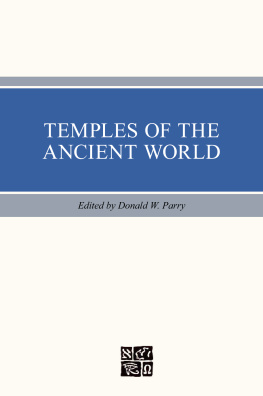The Temple
Where Heaven Meets Earth
Truman G. Madsen
2008 Truman G. Madsen.
All rights reserved. No part of this book may be reproduced in any form or by any means without permission in writing from the publisher, Deseret Book Company, P.O. Box 30178, Salt Lake City Utah 30178. This work is not an official publication of The Church of Jesus Christ of Latter-day Saints. The views expressed herein are the responsibility of the author and do not necessarily represent the position of the Church or of Deseret Book. Deseret Book is a registered trademark of Deseret Book Company.
Preface
For decades, whatever else I have studied or written, I have been motivated to explore vital temple purposes, preoccupied with their origins and applications.
Much that I have learned in this quest is in and between the lines of these chapters.
As a personal manifesto, let me submit four preludes.
First, I remember a turbulent storm one dark night. On the horizon, light penetrated the almost blinding clouds. We could make out, even at a distance, the illumined spires of the Manti Temple.
"You know," said the temple president, "that temple is never more beautiful than during a storm."
So it is with all temples that now extend into every hemisphere.
I have come to know the kinds of storms, both subtle and violent, that we all sooner or later face in this world. I have come to know the beautieswhich include truths and powers and blessings and promisesinside temples that cannot be fully conferred and embraced by covenants anywhere else on the planet.
I have come to know the wisdom of one of my longtime friends who said to me in a solemn settingalmost his last words"All the Lord's answers are in the temple."
He meant answers to daily perplexitiesspiritual and temporal. In the temple they merge.
He meant guiding and comforting answers that come directly from on high amidst sacred silence.
He meant also the temple's peace-giving sustenance, which undergirds the most far-reaching concerns of life, what Hugh Nibley called "getting one's bearings on the universe." These are questings that "stretch to the utmost heavens."
In my own life and that of my family through five generations, I have witnessed and verified these godly influences.
Second, a time ago, we pulled a consortium of experts together. They were focused on Jewish temple lore, and on Jesus and the temple.
Their mastery of biblical and extrabiblical sources gave us new appreciation for ancient and modern sanctuaries. "If you want to know why the Latter-day Saints build temples," said Frank Cross, who is well-known for his studies of the Dead Sea Scrolls, "read the Bible."
Ours is the privilege to know firsthand. Modern temples restore and transcend the communion of earlier sanctuaries. They require us to bring to the altar what is deepest inside us in the spirit of consecration.
Third, we learned of a rabbi who undertook to find the earliest roots in Chaldean and Hebrew of the word we translate "joy."
It led him to the word avodah, which translates as "works" or "service." It refers to the sacrificial ritual of the day of atonement. His book concludes that in antiquity among the Israelites, the most joyous service was temple service.
My cumulative experience and that of my associates demonstrates that there is such resilient joy. The temple is the place where Christ's atonement manifests to us the "peaceable thingsthat which bringeth joy, that which bringeth life eternal" (D&C 42:61).
To miss the joy is to miss the point.
Fourth, it is recognized today that DNA determines multiple traits and dispositions of our bodily makeup. It places an unerasable identification tag on every cell. In this sense we not only have forebears, but we are our forebears.
If we are bold enough, and we are encouraged to be (for from baptism to sealing, the idea of birth and rebirth is the presupposition of every ordinance), we may reverently trace our pedigree beyond the veil and rediscover our celestial parentage.
The intent of the heavens in temples is to extend celestial parenting to our bodies.
The same God who commanded that "Holiness to the Lord" be inscribed on every eastward spire and on every doorknob invites us to be inscribed with his name in every part of our being. His envisioned outcome is that we become as he is: living temples.
In a world that is in crucial need of regeneration, I know firsthand that this process is underway.
It has been said that in the life to come, "There is only one sorrow, not to be a saint."
In contrast there can be supernal joyin us and in the Father and the Sonfor those who have been saintly enough to extend the everlasting influences of the temple to those who come before and after us. For we will open up for them, as for ourselves, creative possibilities in worlds without end.
In sum, I am among the number who know that Christ is the way, the truth, and the life. And his way, his truth, his life are most indelibly infused into our souls in his house, the House of the Lord.
These writings have been available in other compilations, and on web sites. But whether in or out of print, some are hard to find. I have been asked, "Why not bring these chapters together in one place?"
(Apparently many of us are at ease with computer-eze. Yet at times we would rather turn a page than scroll a screen.)
So here in book form are the combined chapters. There is necessarily some repetition, but it has been reduced to a minimum.
Clearly I have not written officially but only as a "layman enthralled."
But if these studies can help readers, anywhere and in anyway, to enhance their temple experience, in the image of the Redeemer, I will be more than grateful.
House of Glory
I begin with a story that goes back before the dedication of the Salt Lake Temple, which took forty years to build. President David O. McKay used to tell of a man who didn't have money enough even to buy shoes to attend a conference in the Tabernacle. During the conference Brigham Young arose and pleaded with the brethren that there needed to be more granite brought for the temple from the quarry about fifteen miles south. It was hauled mostly by ox team. A man came out from this conference and saw another man on the street with a team of oxen. "Why weren't you in there, Brother?"
"Uh, my feet. I didn't feel right about going in."
"Well, Brother Brigham pleaded for more people to get granite."
"All right," said the man, "I'll go. Wo, hah, Buck!" And he started. President McKay's eyes filled with tears as he related that simple incident. The reason why his name and his image come to mind whenever I think of temples is that it was President McKay who performed the wedding ceremony for my wife, Ann, and myself, and that high privilege was possible for us in part because he had done the same for Ann's parents. That morning, very early on a June day, he came in his white suit, a white tie, and white hair. There was majesty in his personality. Somehow we knew then, had we ever doubted it, that no one could speak properly if he spoke evil of the temple, for there before us stood its product.
John the Revelator, John the Beloved, envisioning the city Jerusalem in glorified state, said, "And I saw no temple therein: for the Lord God Almighty and the Lamb are the temple of it" (Revelation 21:22). And then he added that not only would the Lamb reign forever, as we sing, but we, having by then been glorified like unto Him, would likewise reign forever and ever (see Revelation 22:5).















